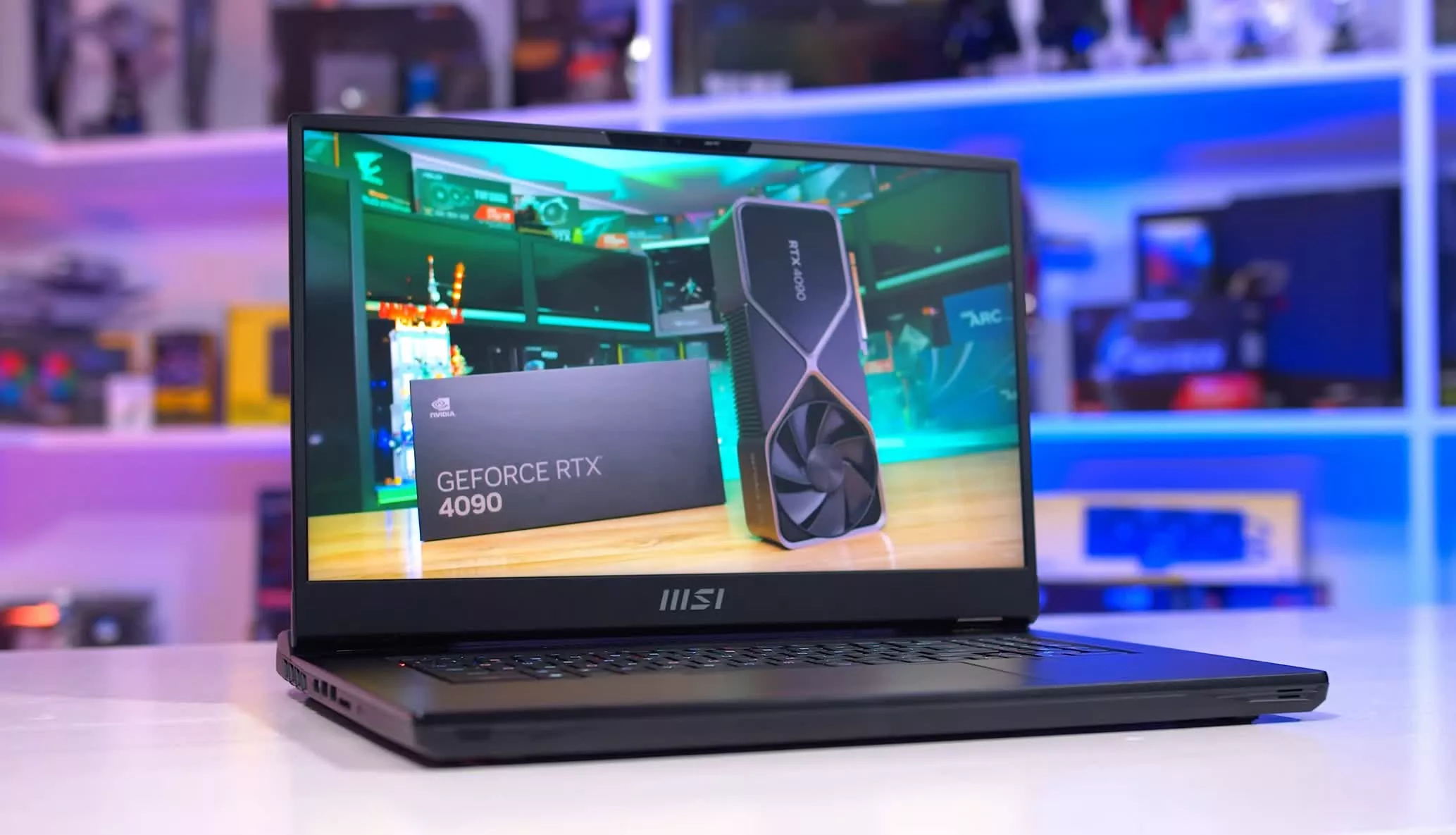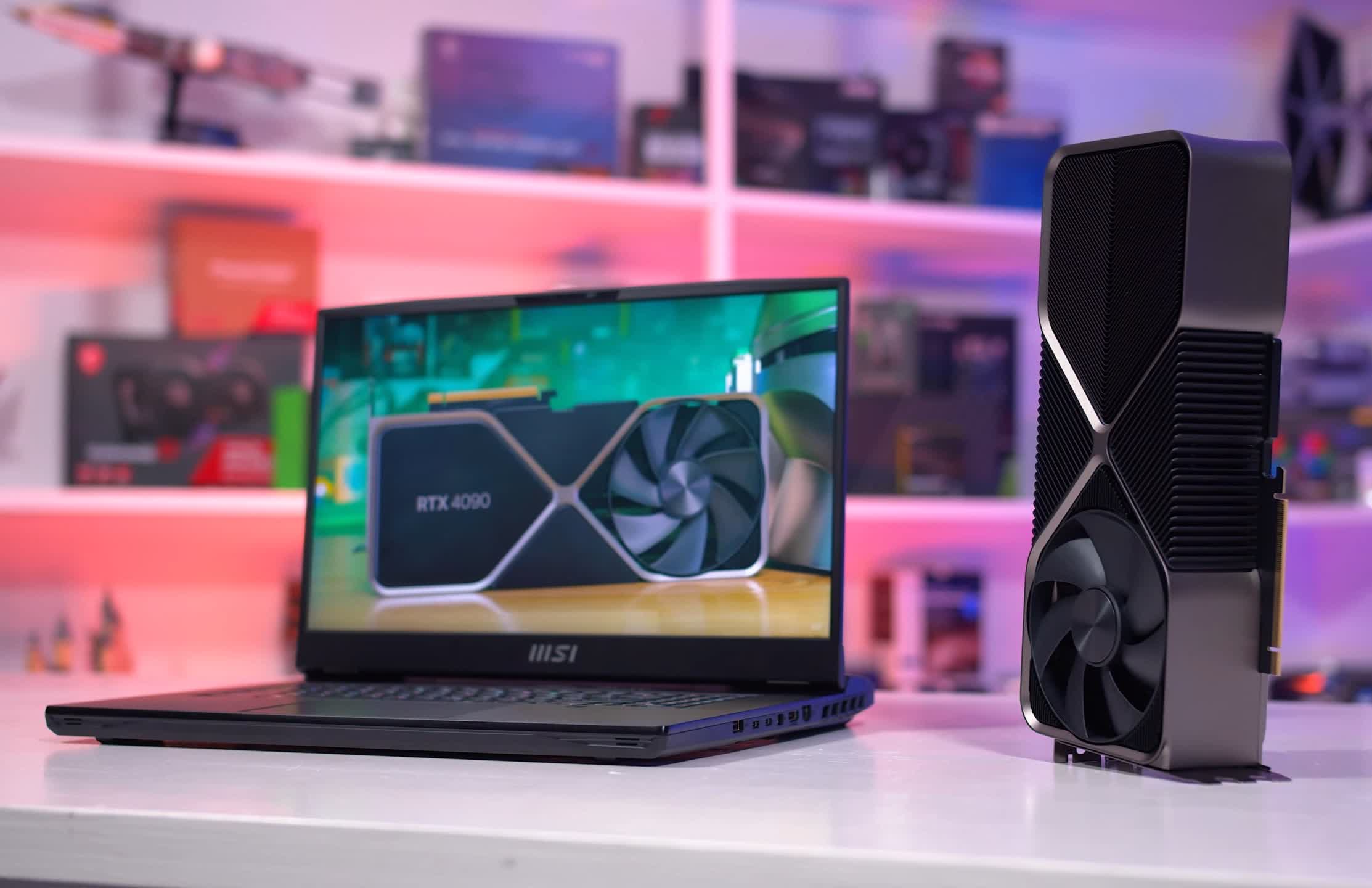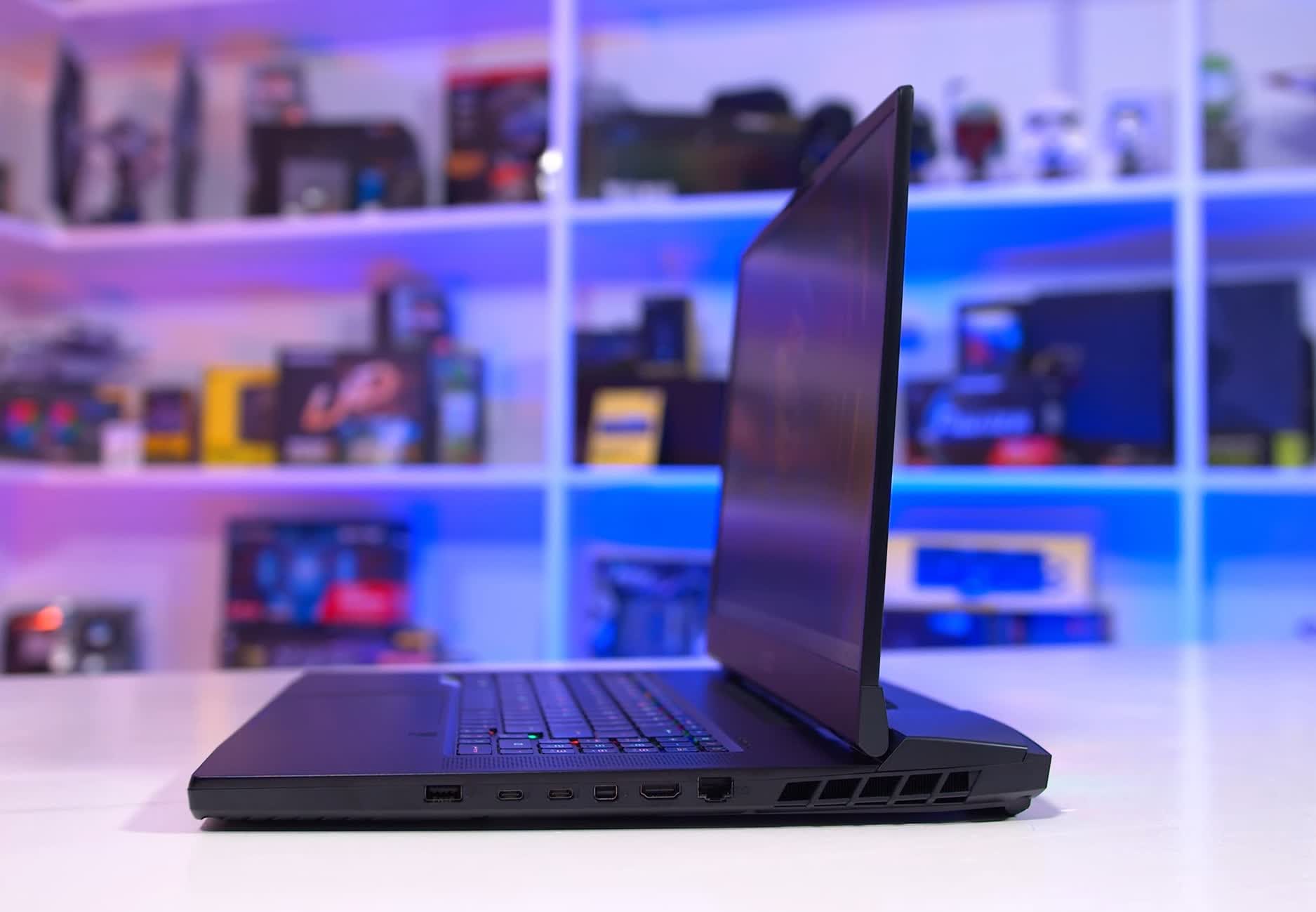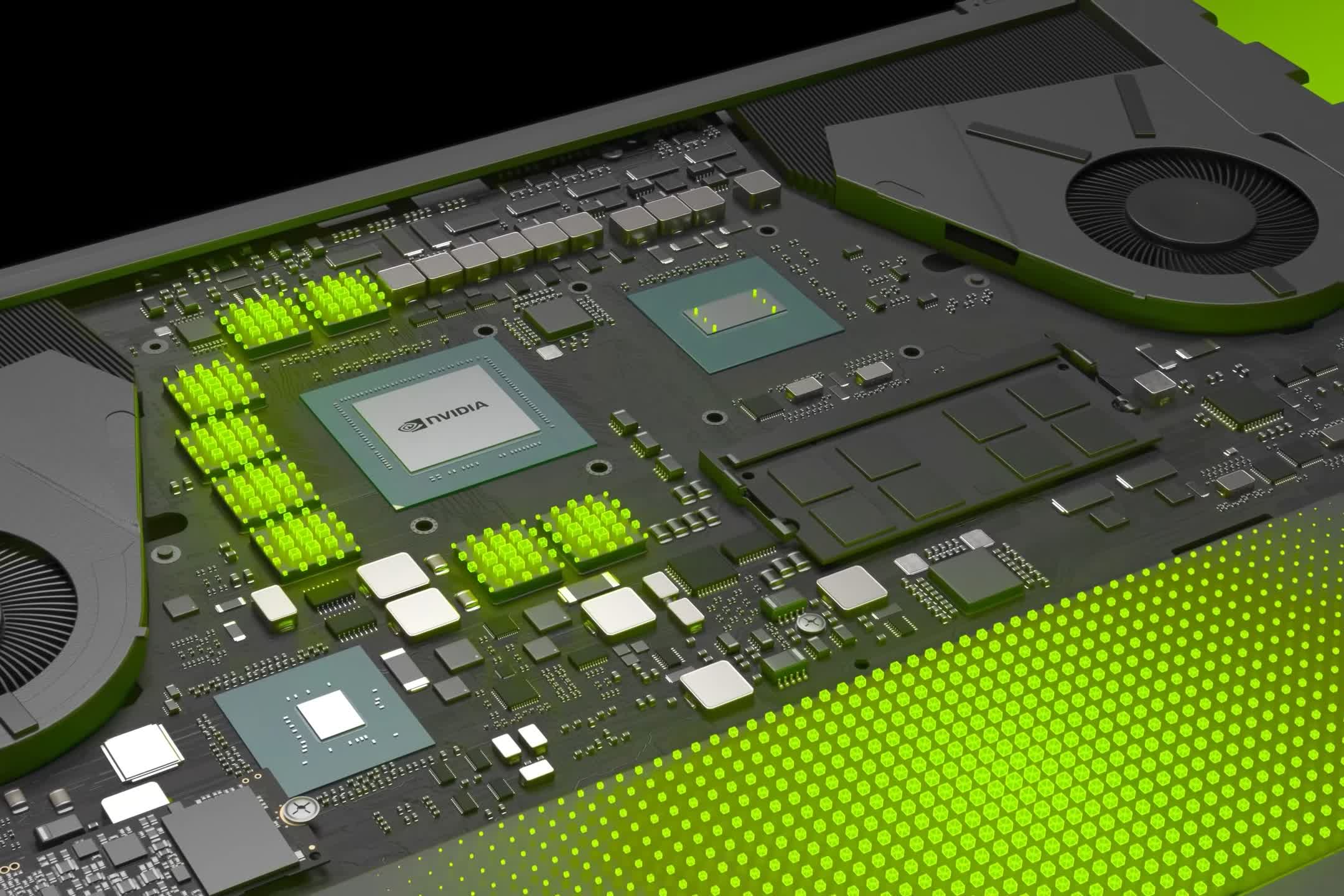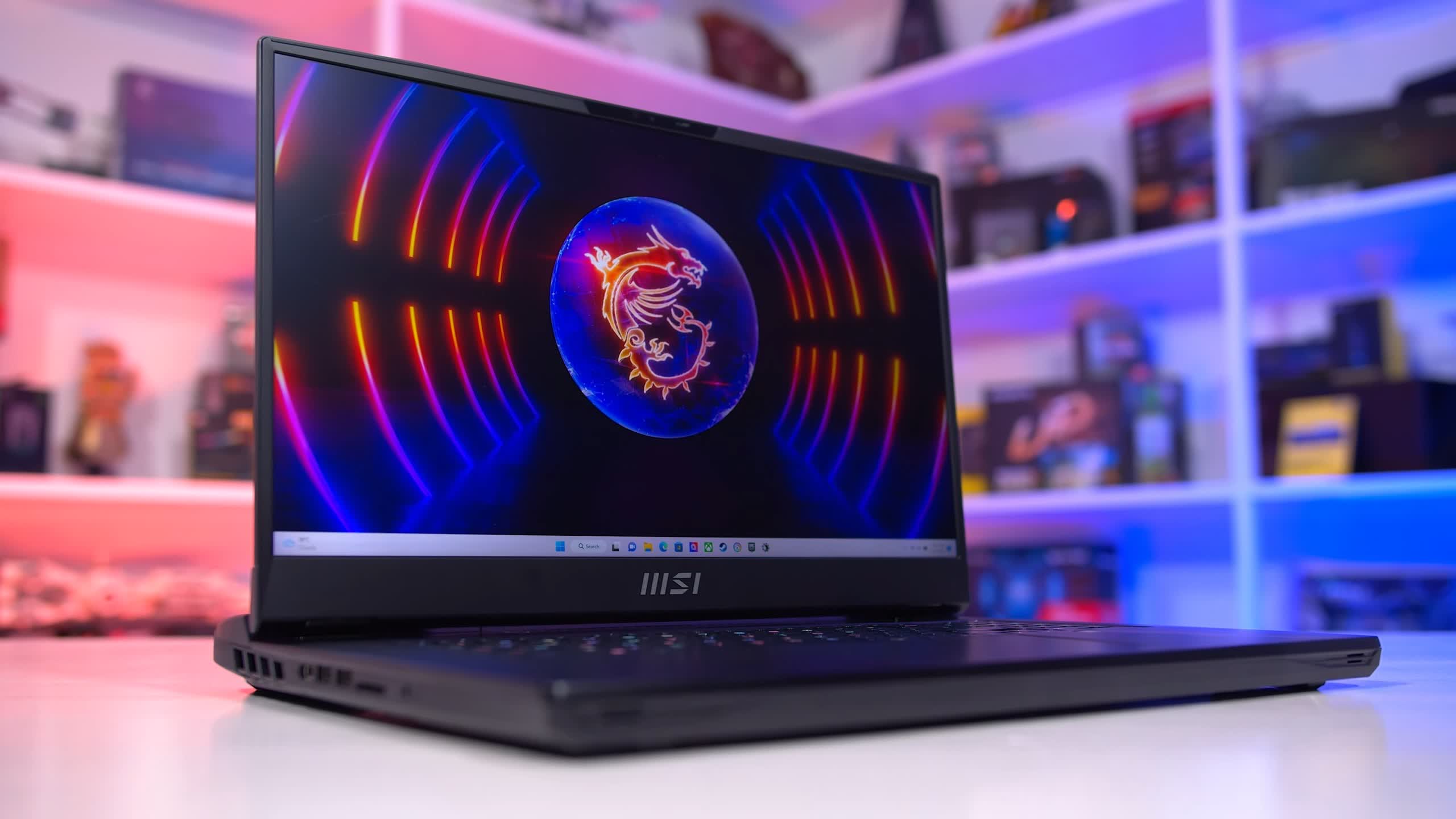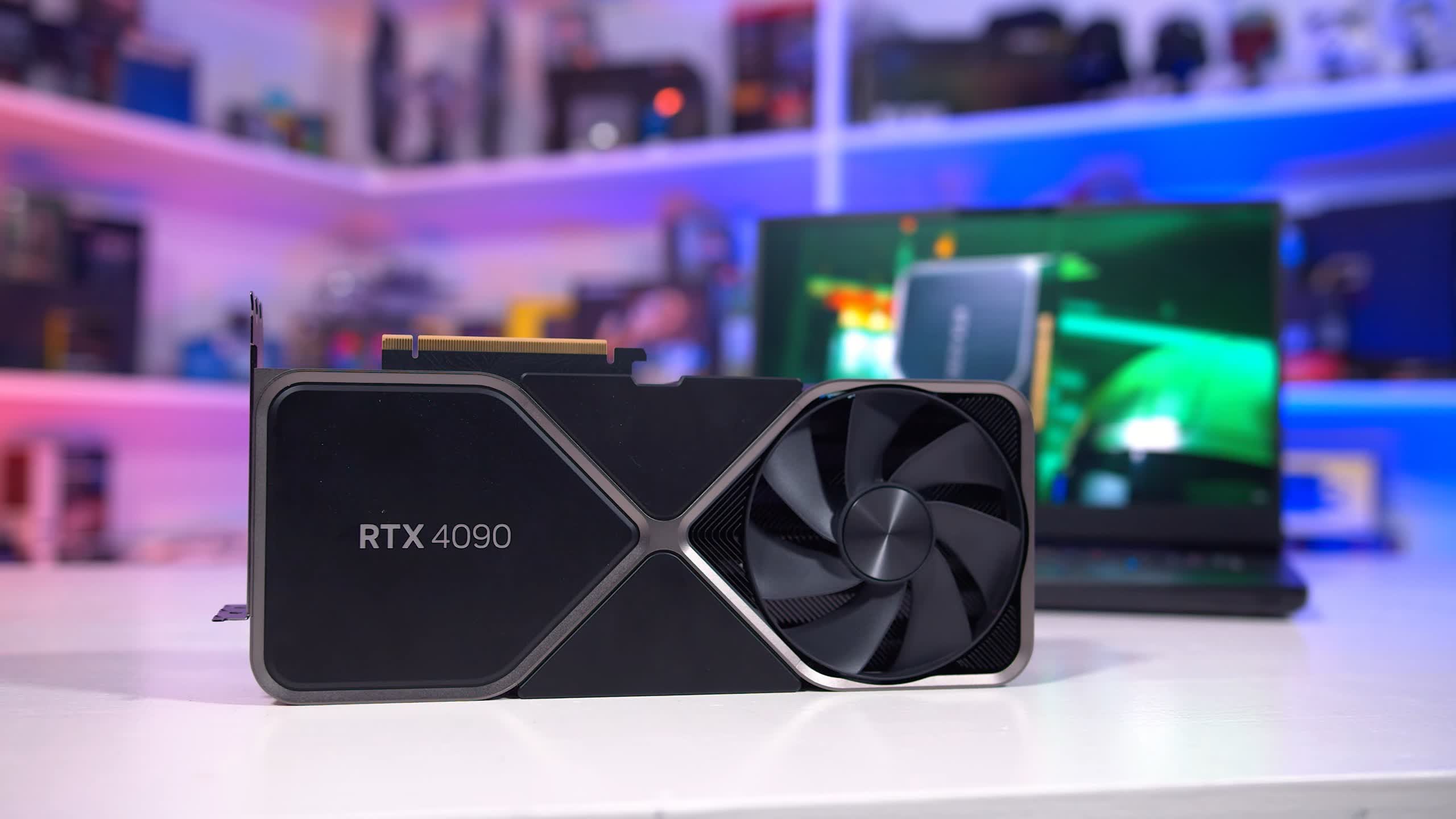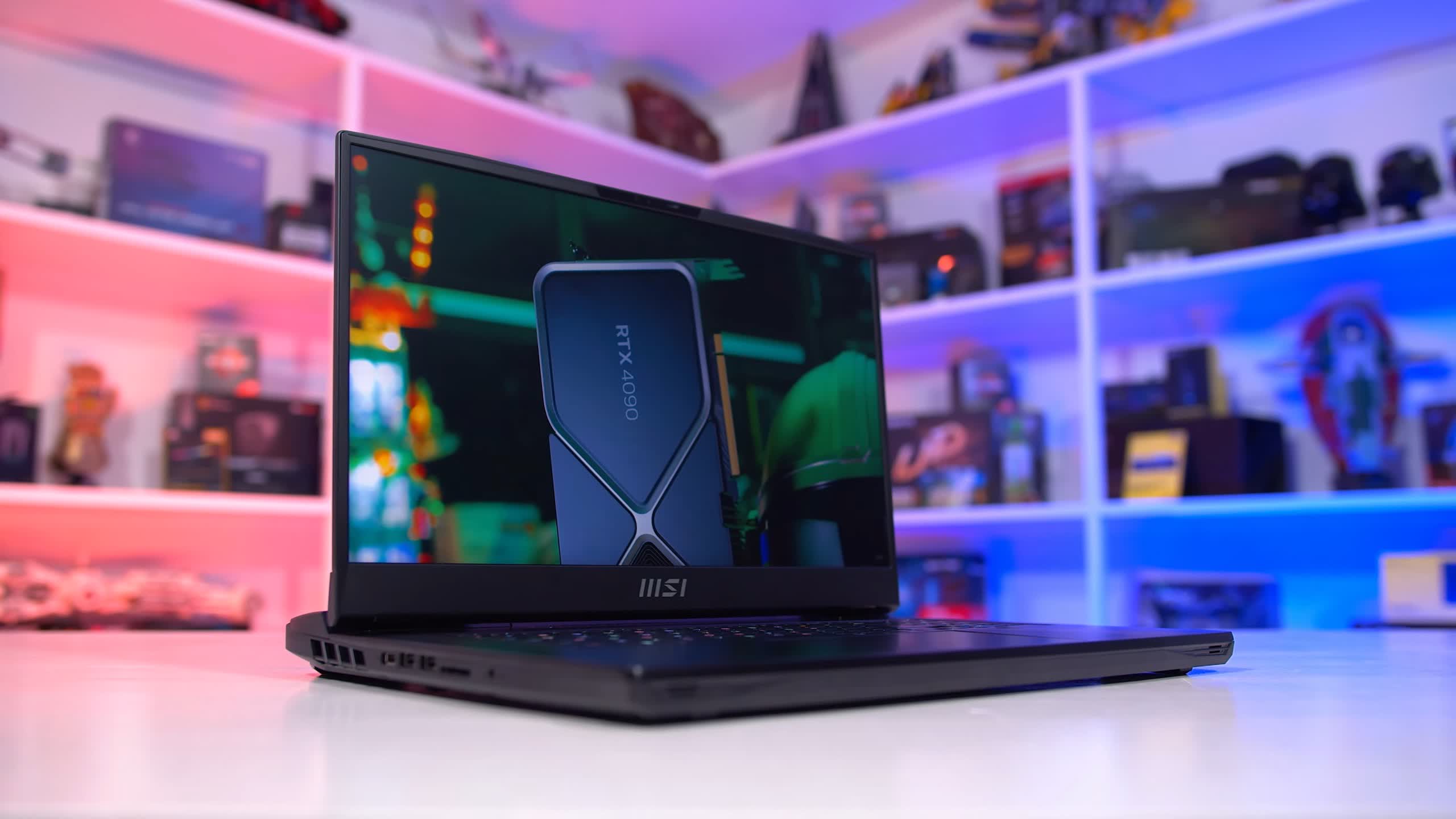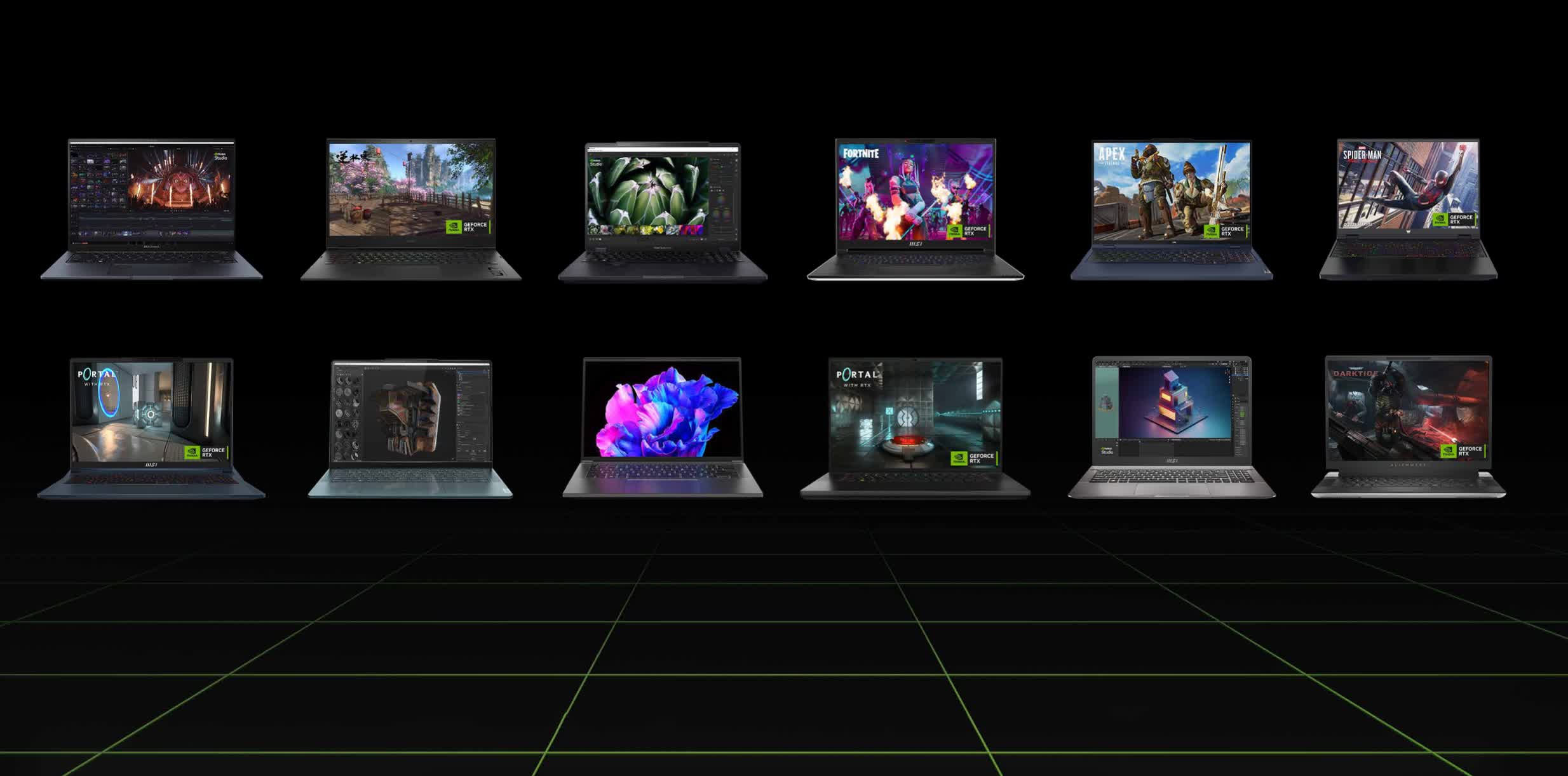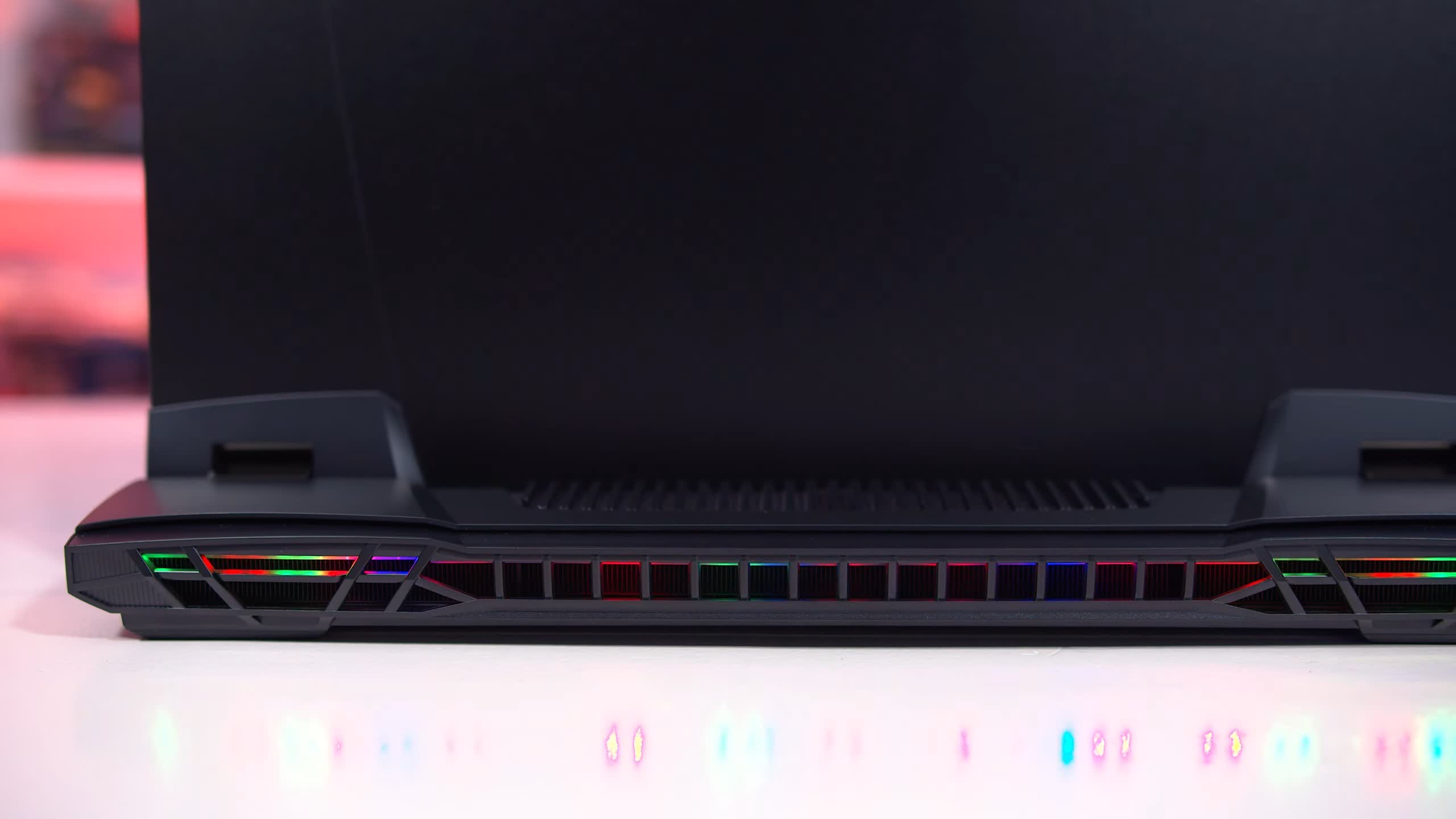Nvidia's new GeForce RTX 4090 Laptop GPU is set to become the fastest mobile GPU for gaming. Since the launch of Ampere about two years ago, things have been stagnant in the gaming laptop space, but with the arrival of the RTX 40 series we're getting a new architecture, a new process node, and new levels of performance.
The RTX 4090 Laptop chip is built using AD103 silicon - the largest that could feasibly fit into a laptop form factor given constraints to size, power, and cooling. This leaves the RTX 4090 Laptop with 9,728 shader units, the same number as the desktop RTX 4080 - as well as several other specs that are shared between those two, such as the 16GB memory capacity and 256-bit bus.
Not unlike previous GeForce GPU releases, the RTX 4090 Laptop GPU is a bit controversial because despite sharing RTX 4090 branding, this mobile variant has little in common with the powerful desktop graphics card we reviewed and tested before. The GPU die, core configuration, clock speeds, memory bandwidth, memory capacity, and power limit are all substantially lower on the 4090 Laptop - yet Nvidia has decided that the 4090 branding makes sense, which is potentially misleading to everyday customers who might not know the difference.
While we consider this a bad move by Nvidia, it's not going to be the focus of this review, instead we'll leave that for an RTX 4090 laptop vs desktop comparison in the near future - spoiler alert - the RTX 4090 desktop demolishes the laptop variant.
In this review, we want to focus on the laptop market and how the new RTX 4090 Laptop GPU compares to the previous flagship, the RTX 3080 Ti Laptop, and what this means for people buying a new gaming laptop in 2023.
To be clear, this is not an RTX 4080 desktop GPU in a laptop either. The RTX 4090 Laptop is clocked considerably lower. At its maximum 150W power configuration, the RTX 4090 Laptop is rated for a 2,040 MHz boost clock, 500 MHz lower than the RTX 4080. It also uses 18 Gbps GDDR6 memory instead of the full 22 Gbps GDDR6X - mostly to save power as G6X is quite power hungry.
| GeForce RTX 4090 Laptop GPU 150W | GeForce RTX 4090 Laptop GPU 80W | GeForce RTX 3080 Ti Laptop GPU 150W | GeForce RTX 3080 Ti Laptop GPU 80W | GeForce RTX 4090 (Desktop) | GeForce RTX 4080 (Desktop) | |
| SM Count | 76 | 76 | 58 | 58 | 128 | 76 |
| Shader Units | 9728 | 9728 | 7424 | 7424 | 16384 | 9728 |
| RT Cores | 76 | 76 | 58 | 58 | 128 | 76 |
| Tensor Cores | 304 | 304 | 232 | 232 | 512 | 304 |
| GPU Core Boost Clock (MHz) | 2040 MHz | 1455 MHz | 1590 MHz | 1125 MHz | 2520 MHz | 2505 MHz |
| VRAM Size and Type | 16GB GDDR6 | 16GB GDDR6 | 16GB GDDR6 | 16GB GDDR6 | 24GB GDDR6X | 16GB GDDR6X |
| Memory Clock | 18 Gb/s | ? | 16 Gb/s | ? | 21 Gb/s | 22.4 Gb/s |
| Memory Bus Width | 256-bit | 256-bit | 256-bit | 256-bit | 384-bit | 256-bit |
| Memory Bandwidth | 576 GB/s | ? | 512 GB/s | ? | 1008 GB/s | 717 GB/s |
| TGP | 150W | 80W | 150W | 80W | 450W | 320W |
| GPU Die | AD103 | AD103 | GA103 | GA103 | AD102 | AD103 |
| GPU Die Size | 379 sq.mm | 379 sq.mm | 496 sq.mm | 496 sq.mm | 609 sq.mm | 379 sq.mm |
| Transistor Count | 46 billion | 46 billion | ? | ? | 76 billion | 46 billion |
Despite this, the RTX 4090 Laptop is a substantial upgrade over the mobile 3080 Ti as it brings 31% more CUDA cores, higher clock speeds on both the GPU and memory, and new features enabled by Nvidia's Ada Lovelace architecture. It also moves from Samsung 8N manufacturing to TSMC 4N, which should deliver a substantial uplift in performance per watt, which is crucial for laptops.
Nvidia will also continue to offer multiple power configurations under the exact same GPU name. That means the RTX 4090 Laptop can be configured anywhere from 80 to 150 watts, the lower power limit will come with a rated boost clock 29% lower than at 150W upper limit.
This is another deceiving aspect to Nvidia's naming scheme, as a customer tossing up between two RTX 4090 laptops could end up buying one by accident that's substantially slower, as it features an 80W TGP instead of the full 150W TGP. With such a large power range, the lower power variants should be given a different name.
In this review we'll be testing the full 150W variant with 25W of dynamic boost, so it's important to be aware that this is effectively the best performance on offer on an RTX 4090 Laptop. If you get a laptop with, say, a 115W limit or 80W limit, you should expect lower performance results than what we are showing here.
The test system for this review is the MSI Titan GT77, which in addition to the fully powered RTX 4090 GPU configuration also includes an Intel Core i9-13950HX CPU, 64 GB of DDR5-4800 memory, and other premium features like a 4K 144Hz mini-LED display. This is not a laptop review, so we won't be touching on things like build quality or how good the keyboard is - but later on we hope to have a full breakdown of Intel's new 13th-gen HX laptop processors, too.
Today's testing was conducted primarily at 1080p using MsHybrid (Microsoft Hybrid Graphics Mode), which presents the most CPU limited scenario and gives us a look at a worst case performance using this sort of GPU. We also have 1440p results using a display connected directly to the discrete graphics, which gives us a better idea of GPU limited results using an external display or an increasingly popular MUX switch. Later in the review, we'll also be exploring 4K numbers against the RTX 3080 Ti Laptop GPU.
Gaming Benchmarks
Starting with Watch Dogs Legion at 1440p using Ultra settings, we see very impressive performance from the RTX 4090 Laptop configuration.
This GPU is capable of a more high refresh rate experience at this resolution, averaging 108 FPS which represents a 59% performance improvement over the 3080 Ti Laptop - that's massive for a generation-on-generation gain at the same 150W power limit.
It also defeats other high end laptop GPUs with ease, such as the RTX 3080 and RTX 3070 Ti.
In the same game at 1080p, we are CPU limited and get basically the same performance as we did at 1440p. This limits the gain relative to the RTX 3080 Ti which isn't as CPU limited at this resolution.
We end up with just a 26% improvement which right from the first game tested highlights how important it will be for new RTX 4090 laptops to use displays with resolutions higher than 1080p.
In Far Cry 6 at 1440p we see a more modest performance improvement relative to in Watch Dogs Legion. Here the RTX 4090 is still much faster than the 3080 Ti Laptop, but we're looking at a 35 percent improvement and we did see some CPU limitations in this benchmark.
This is further highlighted looking at the 1080p numbers, where the RTX 4090 is barely faster than the RTX 3080 Ti, and that's despite a new generation of CPU coming in to play.
The 1440p results in Metro Exodus are extremely impressive. Here the 4090 Laptop at 150W was able to average 155 FPS, enough to max out a 1440p 144Hz display that you might see in a laptop these days.
This gave it a 58 percent lead on the RTX 3080 Ti laptop, again that's a massive improvement.
The gains in this title at 1080p aren't as solid, but we're still looking at a 35% gen-on-gen performance increase which is pretty substantial compared to say, the Turing vs. Ampere era where new RTX 30 laptop GPUs were typically only around the 30% faster mark overall.
Another strong performance lead is shown for the 4090 Laptop in Red Dead Redemption 2. Averaging nearly 130 FPS in this title using High settings puts the 4090 49% ahead of the RTX 3080 Ti Laptop at 150W. This margin drops to 25% at 1080p, but for those with higher resolution panels, there is no doubting the power of the new RTX 40 GPU option.
In Cyberpunk 2077 the RTX 4090 Laptop was able to push above a 60 FPS average for the first time using ultra settings without ray tracing or DLSS, and it doesn't just get slightly more than 60 FPS - it averages 92 FPS which is a whopping 68 percent faster than the 3080 Ti at 1440p. That's a mind blowing gain compared to the previous generation.
But at 1080p the numbers are much less impressive, at just a 20 percent increase gen on gen. Cyberpunk can be quite CPU limited at times and this appears to be the case when we're talking about just 55W of available CPU power.
Horizon Zero Dawn showcases a 32 percent performance increase for the RTX 4090 Laptop at 1440p over the 3080 Ti, which is similar to the results seen in Far Cry 6 earlier. Not every game sees huge performance uplifts, but it's hard to be disappointed with a 32 percent gain either, again this was the norm for gen on gen uplifts from the last couple of generations. At 1080p we see a 25 percent performance uplift which is reasonable and right around the average we saw at that resolution.
It's hard to justify the RTX 4090 Laptop in Guardians of the Galaxy when not using ray tracing. While it does average an impressive 150 FPS at 1440p, this makes it just 19% faster than the 3080 Ti Laptop, which is the weakest result seen so far. And when flicking over to the 1080p numbers that margin drops to just 9 percent, indicating this title is CPU limited at both 1080p and (to a lesser degree) 1440p.
Forza Horizon 5 was a modest showing for the 4090 Laptop, beating the 3080 Ti by 35 percent at 1440p using Ultra settings. This didn't appear to be a CPU limited result though, as the 4090 was also 35 percent faster at 1080p.
The RTX 4090 Laptop loves Resident Evil Village, boasting a 227 FPS average at 1440p using max settings in the area we test - enormous levels of performance. That puts it 68 percent faster than the 3080 Ti, both running at 150W, which is a substantial performance per watt increase. At 1080p the margin between these two GPUs shrunk to 28 percent, which is certainly not as impressive.
In Hitman 3 we also saw huge gains at 1440p, to the tune of a 66 percent increase over the 3080 Ti Laptop in a more GPU limited test scenario using the opening cutscene of the Dubai mission. The performance here is easily sufficient for 1440p 240Hz displays, which is pretty crazy from a laptop. The margin at 1080p between these parts was nowhere near as impressive, just a 15% gain which appears to be strongly CPU limited at this resolution with even a Core i9 processor.
Ray Tracing Performance
When looking at Far Cry 6 using maximum settings, the RTX 4090 Laptop runs into more of a CPU limit than GPU limit, even at 1440p. Previously we saw a 35 percent uplift over the 3080 Ti Laptop in this game, but with ray tracing enabled that margin dropped to 26 percent, and at 1080p we were even more CPU limited with a tiny 8 percent increase. In some titles it does appear the RTX 4090 Laptop is pushing the boundaries of what is possible with today's CPUs.
Performance gains are much more impressive in Cyberpunk 2077 using ray tracing at 1440p. Here we saw a 68 percent performance increase over the 3080 Ti Laptop, matching the margin without ray tracing enabled in this title.
This took the 4090 Laptop up to 44 FPS on average which isn't amazing, but playable after enabling DLSS. The 3080 Ti really didn't cut it in this title even when upscaling is used.
We've also got results at 1080p which highlight again a whopping 68 percent performance gain for the 4090 Laptop vs 3080 Ti Laptop. With ray tracing enabled this game is not CPU limited at 1080p and the 4090 gets to flex its muscles, but this is relatively rare at this resolution.
Guardians of the Galaxy only saw modest improvements for the 4090 Laptop without ray tracing, but with ray tracing enabled at 1440p, the new GPU was capable of a more high refresh experience, averaging 105 FPS without upscaling enabled.
This is a 62% performance increase compared to the 3080 Ti, much more in line with the results seen in other titles. But when dropping back down to 1080p the game is more limited by other factors even with ray tracing enabled, at a 29% increase for these parts.
20 Game Average
RTX 4090 Laptop vs. RTX 3080 Ti Laptop
So far we've looked at 13 game benchmarks in detail, but we actually collected data from 20 games so let's take a look at a head to head comparison between the RTX 4090 Laptop and RTX 3080 Ti Laptop across all games, running at 150-175W for both.
At 1440p the numbers for the RTX 4090 Laptop are very impressive: on average we saw a 48 percent performance improvement, which is massive for a single generation in a power constrained laptop. This has been achieved entirely through a new architecture and new process node, Nvidia was unable to simply push up the power this generation in laptops like they have done on the desktop, but to get a 48 percent gain despite this is huge.
The results will vary depending on the game and configuration. There are some hints of CPU limitations using the RTX 4090 Laptop even at 1440p. Titles such as Guardians of the Galaxy without ray tracing and Spider-Man Remastered saw gains of less than 20 percent.
But on the flip side, there were some titles that saw increases in excess of 60 percent such as Hitman 3, Cyberpunk 2077 and Modern Warfare 2. Ray tracing performance has also increased in line with the gains seen using rasterization, making laptops much more viable for ray traced gaming.
Checking out 4K performance which essentially remove all CPU limitations across the games benchmarked. At this resolution the RTX 4090 Laptop GPU was on average 58 percent faster than the 3080 Ti Laptop, including large gains in titles that were previously a bit CPU limited.
With some titles hitting a 70 percent advantage and a minimum uplift of 45 percent, the RTX 4090 Laptop does make 4K gaming on laptops more of a reality. Most titles hit 60 FPS on average at 4K using the 4090 Laptop with rasterization.
While the 1440p and 4K results are excellent, the RTX 4090 Laptop won't see those margins at 1080p. Compared to the 3080 Ti Laptop, it's still 29 percent faster on average across 20 game configurations, but this is half the gain we saw at 4K and there were several games that weren't even 10 percent faster. We frequently run into CPU bottlenecks at 1080p with the Core i9-13950HX set to 55W, it's just not enough CPU power for this sort of GPU.
Generally we wouldn't recommend buying a 1080p laptop with an RTX 4090, but if you do, it's crucial that the laptop has two extra capabilities: One is a MUX switch that allows a direct connection between the display and discrete graphics. The second is the ability to run the CPU with a power limit of at least 75W, in addition to the GPU running at 150W.
That's a very high total power requirement, but with these two additions we were able to improve 1080p performance by a further 13 percent - and as much as 38 percent in the most CPU limited titles. We'd certainly say the CPU is much more important with the RTX 40 generation than we saw before.
There is also DLSS 3 support present with the RTX 4090 Laptop and this feature does seem like a more useful inclusion than with the RTX 4090 desktop card that smashes most games effortlessly.
When there is a tendency to be CPU limited, DLSS 3 can generate additional frames and increase visual smoothness which is great for single-player titles that aren't latency sensitive. Spider-Man Remastered is one such game that is very CPU limited on modern laptops and doesn't benefit much from the extra performance that the RTX 4090 Laptop GPU offers outside of 4K. DLSS 3 works well in this scenario and is suited to these sorts of constrained systems.
What We Learned
There is no doubting that the GeForce RTX 4090 Laptop GPU is extremely powerful and opens up new possibilities for laptop gaming. With 50 to 60 percent performance improvements compared to the previous leader, the RTX 3080 Ti Laptop, the new RTX 4090 is perfect for 1440p high refresh rate gaming, as well as ray tracing and even 4K gaming at times - often without the need to look into upscaling at all.
This level of performance gain compared to the previous generation is very impressive, it's one of the largest we can remember for laptops and it's doubly so when these gains were seen without any increase to GPU power - something that's not possible in laptops at the moment.
Going from the GeForce RTX 20 to RTX 30 series was about a 30 percent uplift at the same power limit, and it was somewhat similar from the GTX 10 to RTX 20 series. The GeForce RTX 4090 Laptop in a best-case comparison doubles that gen-on-gen increase which is incredible news for laptop gamers, all thanks to the new architecture, chip manufacturing process, and further mobile optimizations.
It's actually pretty crazy to think that a modern flagship laptop in 2023 will possess the performance of an RTX 3090 desktop GPU, which by today's standards is still a very fast graphics card. The RTX 3090 was a 350W GPU, just two and a half years later we're talking about that performance inside 150 to 175 watts. That's just another way to think about the massive performance per watt increase we're seeing this generation.
Nvidia complements this performance nicely with a strong feature set. DLSS 2 continues to be the leading upscaling technology that's the most supported in today's games, and DLSS 3 makes more sense for this type of laptop GPU that can run into CPU limitations. On top of that, we get things like Reflex and Nvidia's encoding. It's a very compelling package for mobile gamers.
On the negatives, we have the misleading branding. While the RTX 4090 Laptop does perform similarly to an RTX 3090 desktop card, that doesn't make it an RTX 4090, not even close. When you're only giving the laptop chip 60% of the CUDA cores seen in the desktop card with the exact same name, it simply should not be called the RTX 4090. Find another name, use an M at the end, anything else would be better.
This is compounded by the power target situation, where an 80W RTX 4090 and 150W RTX 4090 also have the exact same name, but the 80W model will be substantially slower. Imagine reading this review, getting all excited about the performance, going out and buying an RTX 4090 laptop only to find you actually bought one with an 80W GPU that performs 30% worse than what we showed here. That would be bitterly disappointing and could easily be avoided with a more sensible naming scheme.
While not really an issue with the GPU itself, the GeForce RTX 4090 Laptop is powerful enough that it does frequently run into CPU bottlenecks at 1080p and even 1440p at times - and the laptop we used had a high-end Core i9-13950HX processor inside. We would advise against buying an RTX 4090 laptop with a 1080p display because you just won't get the benefit this GPU has to offer. A MUX switch is also essential this generation, as are high CPU power limits and beefy cooling.
To access the highest levels of performance you'll need a laptop with 150W of GPU power and likely 75W or more of CPU power. That's over 200W of combined power and heat to dissipate, which isn't feasible for most laptop designs. Only the largest and heaviest systems can support that level of power, which takes away from the portability of getting a mobile gaming system. The power brick for the MSI Titan GT77 alone is enormous, which you have to carry around in addition to the large laptop itself.
Finally, there's the inescapable roadblock of pricing. Nvidia RTX 4090 laptops are disgustingly expensive. The MSI GT77 used in this review is a $5,000 laptop; that's right. The absolute cheapest model currently listed on Newegg is the Gigabyte Aorus 17X for $3,500, which remains a very expensive option.
Spec over a gaming desktop that includes a Core i9-13900K, a desktop RTX 4090, plenty of memory and storage, good cooling, the works. This is an incredible gaming machine, and because it has a desktop Core i9 and RTX 4090 it will blow away the laptop Core i9 and RTX 4090 in performance. That will set you back around $3,500 without choosing bang for buck components. The same price as the cheapest RTX 4090 laptop.
It seems clear that part of the reason why Nvidia has named this GPU the "RTX 4090" is to allow OEMs to give it price parity with similar desktop configurations. To someone that hasn't done the research, you'd be looking at an RTX 4090 Core i9 desktop for $3,500, or an RTX 4090 Core i9 laptop for $3,500, and thinking they are roughly the same. Why not get the laptop? It's portable, comes with a screen... surely with the same components and price, I'm getting the same thing, right? This obviously isn't the case and is why the prices for these laptops feel absurdly expensive. This kind of relegates RTX 4090 laptops to a niche market segment comprised of huge power hungry laptops unless you buy a thin model and get reduced performance.
Comparing these prices to last generation GPU models, Nvidia launched the 3080 Ti Laptop GPU starting in $2,500 laptops, and these days you're looking at spending about $2,300 at the lowest. That means the cheapest RTX 4090 configurations will be offering about 50 to 60 percent more gaming performance in GPU limited scenarios, at about a 50% higher price. Yes, there's a huge generational leap in performance, but it's hard to get all that excited when it doesn't come with a price to performance improvement. You're thus faced with spending more money in line with the speed increase.
Bottom line, the performance on offer is excellent, the hardware is clearly very good, it's fast, efficient and very impressive. But in this size of laptop and the absurd prices we're looking at, it's hard to recommend to most gamers. With demand for consumers PCs falling, we think flagship RTX 4090-powered laptops will be tough to sell in any significant numbers.
Shopping Shortcuts
- GeForce RTX 4090 Laptops on Amazon
- Intel Core i9-13950HX Laptops on Amazon
- GeForce RTX 3080 Ti Laptops on Amazon
- GeForce RTX 3070 Laptops on Amazon
- AMD Ryzen 9 6900HS Laptops on Amazon
Further Testing
Since we published this review of the GeForce RTX 4090 Laptop GPU, we have run additional benchmarks and comparisons you may be interested in:
